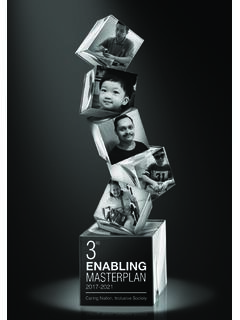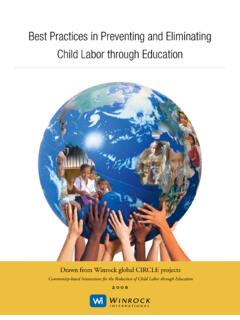Transcription of Reimagining Girls Education Through STEM 2020 - UNICEF
1 Towards an equal future: Reimagining Girls Education Through stem Published by UNICEF Education Section Programme Division3 United Nations Plaza New York, NY United Nations Children s Fund ( UNICEF )October 2020 ISBN: 978-92-806-5178-2 Cover photo: UNICEF /UNI363792/AryanDesign and layout by Roberto C. Rossi AcknowledgementsThe report is a collaboration between UNICEF and the International Telecommunication Union (ITU). The Education Section, Programme Division and the Policy Unit, Office of Global Insight and Policy at UNICEF led the coordination of the report. Ingrid S nchez-Tapia and Andaleeb Alam authored the report with research input from Carolina Belalcazar.
2 Special thanks to Robert Jenkins and Lauren Rumble from UNICEF for providing strategic report would not have been possible without the reviews and insights from Wongani Grace Taulo, Takudzwa Kanyangarara, Atif Rafique, Bassem Nasir, Jasmina Byrne, Sagri Singh, Patty Alleman, Katherine Crisp, Tanya Accone, Maria Jose Velasquez Flores, Simone Vis, Gerda Binder, and Alex Tyers from UNICEF ; Carla Licciardello and Loly Gaitan from ITU; Jennifer Hofmann from Agence Fran aise de D veloppement; and Bruno Mesquita Valle from UNESCO. The Inter-American Development Bank and Fundacion Carvajal also provided technical following colleagues also provided valuable inputs that informed the Call to Action: Gloria Bonder (FLACSO); James Morgan and Yuhyun Park (DQ Institute); Michael Best (Georgia Tech); Anjali Patel and Linarites Viloria (ILO); Justine Sass (UNESCO); and Nora Fyles (UNGEI).
3 Editor: Matthew GibbsSuggested Citation: United Nations Children s Fund, ITU, Towards an equal future: Reimagining Girls Education Through stem , New York, an equal future: Reimagining Girls Education Through stem UNICEF /UNI27788/PIROZZIT owards an equal future: Reimagining Girls Education Through STEMiiiContentsForeword 011. How is the learning crisis affecting Girls ? 032. Why is stem learning so important for Girls ? 073. What are the gender disparities in stem Education ? 134. Why are Girls under-represented in stem ? 155. How can we transform opportunities for Girls Through gender-responsive stem Education ? 19 Call to Action 21 Endnotes 25 UNICEF /UNI27788/PIROZZI UNICEF /UNI341460/RICH Towards an equal future: Reimagining Girls Education Through STEM01 ForewordThe year 2020 marks the 25th anniversary of the adoption of the Beijing Declaration and Platform for Action, the most comprehensive global agenda for Girls and women to date.
4 It expressed unwavering commitment to Girls and women s empowerment and their full participation in all spheres of society. The world has changed rapidly since the Beijing Declaration was adopted, a change driven largely by science, technology and innovation. We see today technological advances that we could only dream about 25 years ago, accompanied by new jobs, new opportunities for economic empowerment and a demand for better educated individuals, especially in science, technology, engineering and mathematics ( stem ) areas. Despite progress, gender equality continues to be elusive. Some areas essential for the achievement of women s empowerment, such as stem , continue to be dramatically lacking in women s participation.
5 Climate change and the COVID-19 pandemic are exacerbating gender and other inequalities and disproportionately affecting women and Girls in all countries. As the world responds to these crises, there is a need for stem knowledge and skills. There is also a steep price of excluding Girls and women from participating in scientific and technological solutions that could save lives. These crises could also be opportunities for innovation and Education , which we need to explore for the sake of Girls . The document shows that the world still faces a learning crisis and a skills crisis that is leaving Girls ill-prepared to develop critical knowledge to participate in the Fourth Industrial Revolution.
6 This risks reversing gains in women s participation in the workforce. It is not intended to be an exhaustive assessment of Girls Education or a comprehensive gender analysis of the stem field. Rather, this document seeks to call attention to the potential of stem Education to transform gender norms in the Education system, to improve quality learning opportunities for Girls , and to highlight key actions that can accelerate Girls transition between Education and technical expert jobs in stem industries. Critically, stem Education also has the potential to contribute to personal empowerment, transformation of communities and nations, and building economies for the evidence presented here provides a foundation for a call to action for global, national and regional actors.
7 All stakeholders are called to work together to dismantle the barriers that Girls face to develop the skills they need to become users, shapers and creators of scientific knowledge and new technologies. Once this ball is rolling, Girls will gain greater ability to choose the skills they want to learn and how to apply them, empowering them to contribute to a gender-equal world. UNICEF /UNI341460/RICH Henrietta H. Fore Executive Director, UNICEFD oreen Bogdan-Martin Director, Telecommunication Development Bureau, ITU UNICEF /UNI27790/PIROZZIT owards an equal future: Reimagining Girls Education Through STEM03 The last 25 years has seen a steady rise in Girls access to Education around the world.
8 In 1998, there were 143 million Girls of secondary school age out of school compared to 127 million boys1. Today, 97 million Girls and 102 million boys of secondary school age are out of school. Yet for many children, just being at school does not mean they are learning. By 2030, some 880 million children will not be on track to develop the skills they need to succeed in the This means that millions of children and young people are not developing the skills they need to successfully transition to adulthood. We are facing a learning crisis, which is leading to a skills crisis. For Girls and women, this crisis includes difficulty accessing quality learning opportunities in Science, Technology, Engineering and Mathematics ( stem ) subjects traditionally ascribed to and dominated by boys and men and lower levels of achievement in digital skills3.
9 Education systems have allowed gender divides to be perpetuated and to disproportionally affect the most marginalized Girls . While Girls tend to outperform boys in reading skills in most regions, they continue to be under-represented amongst top-performers in stem subjects, and women continue to be under-represented in the stem workforce. This is a tremendous waste of talent and human potential. The under-representation of Girls and women in stem is deeply rooted in unequal gender norms that tell us that Girls are not cut out for subjects that require problem solving and an inquisitive mind. Girls deserve to access an Education that prepares them for the jobs of the future and to be ready and equipped to participate in the Fourth Industrial Revolution.
10 To give all Girls opportunities to learn, achieve and excel in science, technology, and in engineering solutions, we need to reimagine Education systems where gender-responsive stem learning happens in every classroom (Figure 1). In addition to the stem gender divide, there is a digital divide in the largest youth generation the world has ever seen4. In developed countries, 94 per cent of young people aged 15-24 use the internet compared with 67 per cent in developing countries and only 30 per cent in Least Developed Countries5. As COVID-19-induced school closures and lockdowns have shown us, this divide limits most children from accessing the same learning opportunities and quality stem Education as their better-connected peers, leaving Girls further behind.












